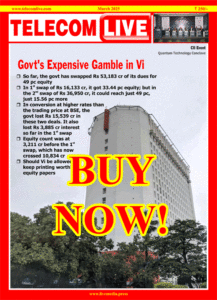Telecom spectrum in 6-Ghz band key to avoid 5G radio wave crunch: COAI
Non-allocation of telecom spectrum in 6-Ghz band could lead to a radio wave crunch for high-speed 5G services, a key growth driver for the country’s digital economy and development of emerging technologies specially artificial intelligence, industry body COAI said on Tuesday.
India needs an additional 2 giga hertz of mid-band spectrum to meet the international standard of ‘IMT-2020’ user experience to ensure data rates of 100 megabit per second (mbps) on downlink and 50 mbps on uplink in densely-populated cities, COAI Director General S P Kochhar told PTI, citing global telecom industry GSMA.
“While the government is considering vacating the spectrum in C-band, i.e., 3,670-4,000 MHz for 5G/6G use, it may not be enough to reach the required 2 GHz spectrum for IMT (5G/6G) in mid-band. Therefore, we want to stress on the fact that it is essential that the most optimal allocation of the 1,200 MHz available in the 6 GHz band is done for mobile communications in India, to get this critical 2 GHz of spectrum in mid-band,” Kochhar said.
Wifi service providers have been demanding de-licensing of spectrum in 6 Ghz, which will make the wave useful for providing internet services.
The Cellular Operators Association of India (COAI), whose members include Bharti Airtel, Reliance Jio, Vodafone Idea etc, has opposed delicensing of that spectrum.
“Delicensing of a spectrum which has a commercial value will incur loss to the national exchequer. We reiterate that the demand for delicensing the 6 GHz band for Wi-Fi 7 technologies is unjustified as Wi-Fi 7 is spectrum-agnostic and therefore, can utilise other spectrum bands to provide better performance,” Kochhar said.
The government has already de-licensed 605 MHz spectrum in the 5 GHz frequency band.
Kochhar said that the de-licensed radio waves still have not been effectively utilized as 255 MHz of this band remain unutilized.
He further said that wider and seamless mobile network coverage is required for the growth of the digital economy that is playing a pivotal role in job creation and making India globally competitive.
When asked about the practice of delicensing spectrum in 6Ghz band in several countries, Kochhar said that the 6Ghz band has been made free for use only in the regions that already have an extensive optical fibre cable network, whereas India does not have such a density of OFC to a large cross section of the population both in urban and rural areas.
“Moreover, Indian population density is more than all of these countries viz: with a population density of 464 people per square kilometres. India is at multiple times more than other countries like Canada (108x), Norway (32x), Saudi Arabia (29x), Brazil (18x), USA (13x), etc. All these countries have an extensive wireline/OFC infrastructure,” he said.
The COAI DG said that many nations like US have realised that delicensing of spectrum is an irreversible process and hence any consideration for such a decision should be examined with diligent deliberation and detailed techno-economic analysis in India for assignment of any of the 5G spectrum, including the 6 GHz band is imperative.
Once the mid-band radiowave is exhausted, mobile phone service providers will get frequencies in higher bands in which signals cover less area. The cost of rolling out public telecom services increases in higher frequency ranges.
Kochhar said that the 6 GHz mid-band provides a balance of wide coverage and capacity, which is critical to the rapid and cost-efficient deployments of 5G mobile networks in India and also meets the exponentially increasing data demands, that too at affordable terms.
“This would maximize the economic and societal benefits for achieving the national target of 1 trillion digital economy. Further, it would also help meet the growing demand for 5G services and prepare for future technologies like 6G,” Kochhar said.


